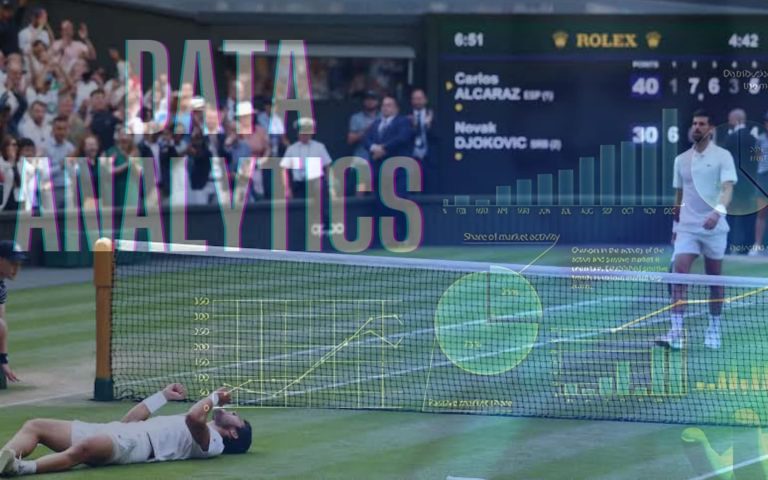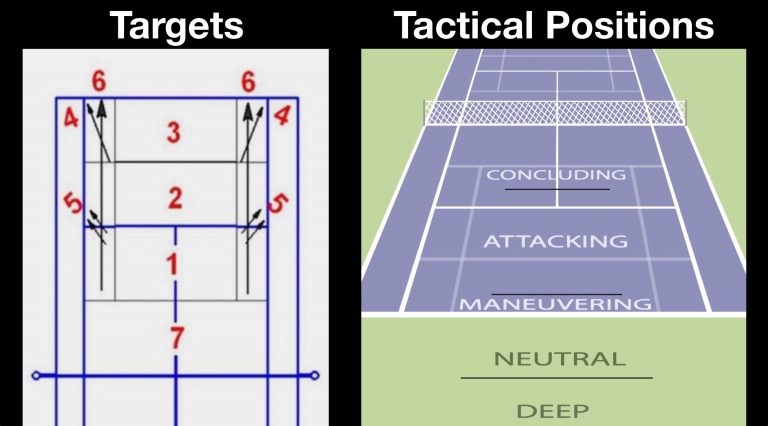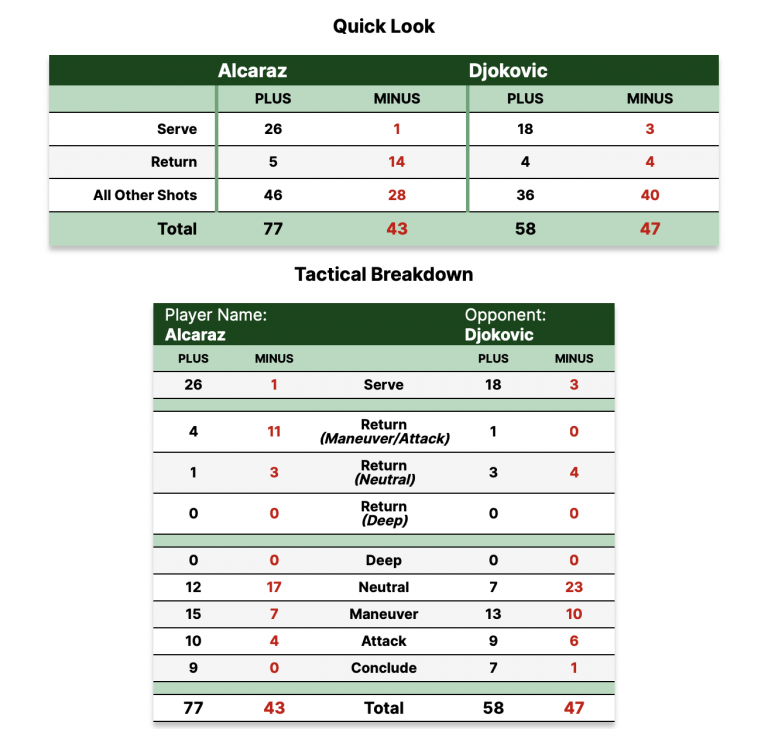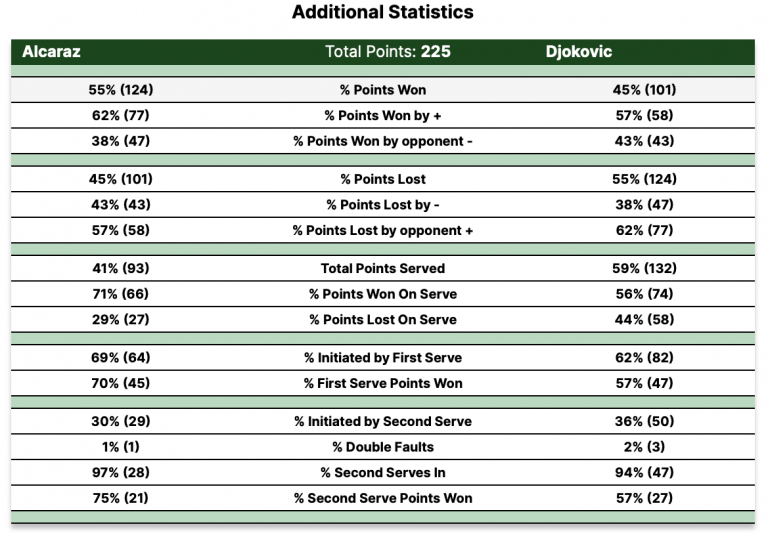
While there’s quite a bit of tennis yet to be played at this year’s US Open, the possibility of another clash between Alcaraz and Djokovic looms in the backdrop of the men’s singles draw.
In Part 1 of this article series, we looked at how 7 Shot Tennis analytics told the story of how Djokovic won the first and fourth sets in the 2023 Wimbledon Final over Alcaraz, putting himself in position to win his 24th major title and continuing his quest for a calendar year grand slam.
But to many, a simple question remains. How did the rising star from Spain have enough to unseat the Serbian – who continues to delay the sunset of his remarkable career? How did the 20 year old Alcaraz, in just his fourth ATP level grass court tournament, defeat a grass court veteran with 7 Wimbledon titles? Our 7 Shot Tennis statistical data reveal the clear path Alcaraz took to win this 5 set thriller.
Obviously, compared to the 2 sets he lost, Alcaraz raised his level of play during the 3 closely contested sets he won over Djokovic, especially in 2 key areas. And he made an important adjustment in another key area that made a significant difference.
In the 3 sets he won, Alcaraz had tangible performance improvements on serve and in the Neutral tactical position.
The analytics reflect a more aggressive serving strategy, particularly on his second serve. The numbers also indicate a willingness to stay in rallies as long as necessary, play defense when he had to, and use his explosive forehand to control points whenever possible to create opportunities to maneuver, attack and conclude. Establishing some patience in his shot selection allowed him to use his movement and speed as a weapon.
Alcaraz won the second, third and fifth sets. In these 3 sets, the Spaniard had 77 Pluses and 43 minuses in total, while Djokovic had 58 total Pluses and 47 minuses.
For those unfamiliar, the 7 Shot Tennis system of recording point-ending shots utilizes an intuitive Plus – Minus system. Pluses consist of aces, winners & shots that result in a forced error by the opponent, while minuses are unforced errors & double faults. For every plus or minus, the stroke used, tactical position and target area are also recorded. This enables us to generate data that consists of where all point-ending shots are hit from and where they are hit to.

Check out a short edit of the 3 sets Alcaraz won in the video.
In the 3 sets Alcaraz won, both players had extremely positive Plus / Minus Differentials on Serve, earning themselves a lot of free points from un-returnable serves with limited double faults. Alcaraz had an edge over Djokovic though, with the Spaniard earning 26 Pluses on Serve with only 1 Minus. Djokovic had 18 Pluses and 3 Minuses.
Alcaraz turned this match around on second serve points and second serve return points as much or more than anything else.
Alcaraz won 70% of his first serve points and a remarkably high 75% of his 2nd Serve points during these 3 sets, while Djokovic won a slightly below average 57% of points on his 1st Serve points and an above average 57% of points on his 2nd Serve.

Despite losing these 3 sets, Djokovic continued to have a better Plus / Minus Differential than Alcaraz on the Return. Djokovic finished these 3 sets on even footing in this regard, with 4 Pluses on Return and 4 Minuses, with 7 of those 8 statistics coming from Returns hit from the Neutral area.
In the 3 sets Alcaraz won, he had 4 Pluses and 11 Minuses when hitting Returns from the Maneuvering area. These numbers, however, do not tell the whole story of how his return of serve evolved over the course of the match.
With a clear strategy to take time away from Djokovic, doing so on second serve returns was an area where Alcaraz had a low success rate in the first 2 sets of the match. With the first set being so one-sided, Alcaraz didn’t win much of anything in any area. But in the second set alone, Alcaraz hit 12 returns from the maneuvering area and won 3 of those points, all of which occurred when Djokovic hit a second serve.
This perhaps had something to do with going for too much pace on many of these returns from the maneuvering area. Overall, he didn’t seem get much a read of Djokovic’s serve at this stage of the match. Even after making returns from the maneuvering tactical position, he found himself on defense on the next shot.
In contrast, of the 3 total points Alcaraz hit a second serve return from the Neutral area in the second set, he won 2 of them. Over the course of the second, third and fifth sets, Alcaraz had 1 Plus and 3 Minuses overall when hitting Returns from the Neutral area.
Once the third set began, Alcaraz made an adjustment on his second serve return – and it was one of the most pivotal things he did in the match.
He began to anticipate the Djokovic second serve, made some footwork adjustments and began hitting returns with a more high percentage pace compared to the first 2 sets. This enabled him to get into far more rallies and trade neutral ground strokes.
In the third set, Alcaraz won 3 out of the 5 points where he hit a second serve return from the neutral area, and he won 7 out of the 14 points played when he hit a second serve return from the maneuvering area.
In the fifth set, Alcaraz won 0 of the 2 points when he hit a second serve return from the neutral area, and he won 5 out of the 9 points played when he hit a second serve return from the maneuvering area. His strategy to take time away from Djokovic on the return was working more often because he was hitting most of these returns in a more high percentage pace, and more often his returns were landing deep in the court in Target area 3.
In the 3 sets Alcaraz won, both players finished with a negative Plus / Minus Differential in the Neutral Tactical Position during rallies. With 12 total Pluses and 17 Minuses, Alcaraz, had a significantly better Plus / Minus Differential over Djokovic, who had 7 total Pluses and 23 Minuses in the Neutral Tactical Position in these 3 sets.
This speaks to a vital aspect of the path Alcaraz took to win this match. Perhaps his coach, Juan Carlos Ferrero (who reached 3 major finals, won the French Open and was world #1) helped his pupil realize that a 20 year old with incredible movement, speed and endurance could have an edge over the 36 year old Djokovic in an important fitness component – the ability to recover quickly after long points and be physically ready to play the next point with poise and composure.
The young, explosive world number 1 with incredible speed, great ground strokes and versatility extended rallies when he could. Over time, Alcaraz’s consistency and effectiveness in the neutral area began to wear on Djokovic, who began to make uncharacteristic errors more frequently as the match progressed.
Alcaraz’s consistency broke Djokovic down.
While media talking heads and even Djokovic himself spoke about how his backhand let him down in this match in a post-match interview, the Serbian’s forehand cost him just as much and more during the 3 sets that Alcaraz won. When we combine Djokovic’s Neutral and Maneuvering forehand stats in the sets he lost, he had 13 Pluses and 18 Minuses. Djokovic’s total backhand metrics in the Neutral and Maneuvering areas were 7 Pluses and 12 Minuses.
Alcaraz played great offense early and often in the 3 sets he won.
Often behind effective serving and shots from neutral positions that pushed Djokovic back deep or pulled him wide, the Spaniard was able to frequently finish points in Offensive Positions (Maneuvering, Attacking and Concluding). Alcaraz had a high overall success rate on offense during the 3 sets he won, with 34 Pluses and 11 Minuses. Djokovic had 29 total Pluses and 17 Minuses when hitting from offensive positions, with 10 of his 17 errors coming from the Maneuvering area.

Alcaraz showed great fight and composure in the second set of this match, dug himself out of a hole and turned the match around. With a little luck, a lot of great shot making, and some key strategic adjustments, he was able to to steal the second set and really shift the momentum in his favor in the third. But in the fourth set, the ebb of Alcaraz’s momentum began to recede. Djokovic did what great champions often do – and he came storming back to even the match to set up a fifth and decisive set for the title.
Part 3 of this article series will take a look at how Alcaraz often walked the line between genius and insanity in that epic fifth set.
